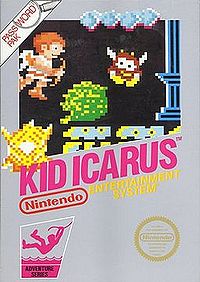Kid Icarus: Difference between revisions
mNo edit summary |
m (Don't use you) |
||
| Line 15: | Line 15: | ||
}} | }} | ||
''This article is about the video game. | ''This article is about the video game. For the protagonist of the game who is sometimes referred to as "Kid Icarus", see [[Pit]].'' | ||
'''''Kid Icarus''''' ({{ja|光神話 パルテナの鏡}}, ''Hikari shinwa: Parutena no Kagami'', '''Myth of Light: The Mirror of Palutena''') is a platforming video game developed by Nintendo R&D1 and published by [[Nintendo]] for the Famicom Disk System in 1986 and the [[nwiki:NES|Nintendo Entertainment System]] in 1987. It is the first game in the ''Kid Icarus'' series, the second being ''Kid Icarus: Of Myths and Monsters'', released on the Game Boy. Another sequel for the SNES, ''Kid Icarus 2'', was never released. The game world is loosely based on Greek mythology, with Icarus and Medusa being drawn from myth. | '''''Kid Icarus''''' ({{ja|光神話 パルテナの鏡}}, ''Hikari shinwa: Parutena no Kagami'', '''Myth of Light: The Mirror of Palutena''') is a platforming video game developed by Nintendo R&D1 and published by [[Nintendo]] for the Famicom Disk System in 1986 and the [[nwiki:NES|Nintendo Entertainment System]] in 1987. It is the first game in the ''Kid Icarus'' series, the second being ''Kid Icarus: Of Myths and Monsters'', released on the Game Boy. Another sequel for the SNES, ''Kid Icarus 2'', was never released. The game world is loosely based on Greek mythology, with Icarus and Medusa being drawn from myth. | ||
Revision as of 08:02, May 4, 2013
| Kid Icarus | |
|---|---|
 File:KidIcarusSymbol.png | |
| Developer(s) | Nintendo R&D1 |
| Publisher(s) | Nintendo |
| Designer(s) | Satoru Okada |
| Released | |
| Genre(s) | Platformer |
| Platform(s) | Nintendo Entertainment System Family Computer Disk System Game Boy Advance Virtual Console |
| Article on Icaruspedia | Kid Icarus |
This article is about the video game. For the protagonist of the game who is sometimes referred to as "Kid Icarus", see Pit.
Kid Icarus (光神話 パルテナの鏡, Hikari shinwa: Parutena no Kagami, Myth of Light: The Mirror of Palutena) is a platforming video game developed by Nintendo R&D1 and published by Nintendo for the Famicom Disk System in 1986 and the Nintendo Entertainment System in 1987. It is the first game in the Kid Icarus series, the second being Kid Icarus: Of Myths and Monsters, released on the Game Boy. Another sequel for the SNES, Kid Icarus 2, was never released. The game world is loosely based on Greek mythology, with Icarus and Medusa being drawn from myth.
Kid Icarus has been re-released twice: on August 10, 2004, for the Game Boy Advance as part of the Famicom Mini Series in Japan only, and on February 12, 2007, on the Wii's Virtual Console in North America. It was released on the European and Australian Virtual Consoles on February 23, 2007.
Super Smash Bros. series
In Super Smash Bros. Melee, Pit appears as a collectable trophy. The description includes "Will Pit ever fight again?", a possible hint that Pit could appear in a later game.
In Super Smash Bros. Brawl, Pit is a playable character. His character design within the game is said to be a "huge leap forward in his evolution," designed by the same character designer of Twilight Princess. Kid Icarus also appears as one of the Masterpieces available to demo. Here, the player as one minute and thirty seconds to play through the first level of the game. The game is also embodied in a stage; Angel Land itself appears in Skyworld and is featured prominently in the Subspace Emissary. As all the other fighters, Pit has his own trophy in Brawl, as does his Final Smash, Palutena's Army. Palutena and the Centurions, the warriors Pit must free from stone in the fortress levels of Kid Icarus, make an appearance as part of Pit's Final Smash, and Palutena is given her own trophy. Palutena's Bow also is given it's own trophy. Several stickers from Kid Icarus appear, such as Pit, the Grim Reaper, and the Eggplant Wizard.
Gallery
- Eggplant Wizard Sticker.jpg
Eggplant Wizard Sticker.
- Picture 5.png
Pit's trophy in Melee.
- KIMasterpiece.png
Screenshot from the Masterpiece in Brawl.
Trivia
- The game's name is a reference to the Greek mythological character Icarus, a human whose father made two pairs of wings out of wax and feathers for them to escape the island of Crete.
| Masterpieces in Super Smash Bros. Brawl | |
|---|---|
| Starter games | Ice Climber · Kid Icarus · Kirby's Adventure · Star Fox 64 · Super Mario Bros. · Super Metroid · The Legend of Zelda |
| Japan-only games | EarthBound · Fire Emblem: Mystery of the Emblem |
| Unlockable games | Donkey Kong · F-Zero · Super Mario Bros. 2 · Super Mario World · The Legend of Zelda: Ocarina of Time |